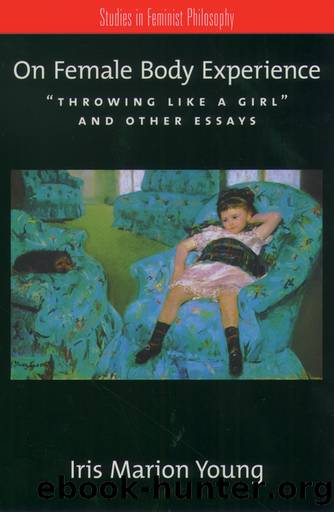On Female Body Experience by Young Iris Marion;

Author:Young, Iris Marion;
Language: eng
Format: epub
Publisher: Oxford University Press USA - OSO
Published: 2005-07-15T00:00:00+00:00
* * *
1. Erwin Straus locates the self as consciousness phenomenologically in the head but mentions the chest or trunk as an important location of the self in movement and a sense of immediate affective experience of the self in the world; see “The Forms of Spatiality,” in Phenomenological Psychology (New York: Basic Books, 1966), 22–27. Seymour Fischer finds heart awareness an important variable in body consciousness; see Body Experience in Fantasy and Behavior (New York: Appleton-Century Crofts, 1970), especially chapter 27.
2. See Barbara Ann Brenna, Hands of Light (New York: Bantam Books, 1987), 132–35.
3. One of the women interviewed by Ayalah and Weinstock relies on the ideas of yoga to suggest that her sense of herself and her relation to her breasts influenced her entire being in the world as either tight or relaxed in the chest.
4. Many of the women interviewed by Ayalah and Weinstock trace significant aspects of their adult personalities to their adolescent experiences of breast development.
5. See Sandra Bartky, “On Psychological Oppression,” in Philosophy and Women, ed. Sharon Bishop and Marjorie Weinzweig (Belmont, Calif.: Wadsworth Publishing Co., 1979), 33–41; and E. Ann Kaplan, “Is the Gaze Male?” in Women and Film: Both Sides of the Camera (New York: Methuen, 1983), 23–35.
6. See Martin Heidegger, What Is a Thing?, trans. W. B. Barton and Vera Deutsch (Chicago: Henry Regnery Co., 1967).
7. Carolyn Merchant takes “context independence” to be one of the defining characteristics of the materialist mechanical view of nature, which triumphed over an organic view of nature in the seventeenth century. See The Death of Nature (Berkeley: University of California Press, 1980), chapter 9.
8. I am thinking of Irigaray’s attention to the property and commodity basis of objecthood; “Women on the Market,” in This Sex Which Is Not One (Ithaca, N.Y.: Cornell University Press, 1985), 170–91.
9. “Forget Hemlines: The Bosomy Look Is Big Fashion News,” Wall Street Journal (December 2, 1988); Jeremy Weir Alderson, “Breast Frenzy,” Self (December 1988), 83–89.
10. Susan Bordo suggests that achievement society takes Western culture’s denial of the body and fleshiness to extremes, projecting norms of tightness and hardness for all bodies. This is the particular contemporary cultural meaning of the demand for slenderness in both men and women, but especially in women. Bordo does not mention breasts specifically in this discussion, but clearly this analysis helps us understand why media norms of breasts make this impossible demand for a “firm” breast. See Bordo, “Reading the Slender Body,” in Body/Politics: Women and the Discourses of Science, ed. Mary Jacobus, Evelyn Fox Keller, and Sally Shuttleworth (New York: Routledge Chapman and Hall, 1989), 83–112.
11. See Sandra Bartky, “Foucault, Femininity, and the Modernization of Patriarchal Power,” in Feminism and Foucault: Reflections on Resistance, ed. Irene Diamond and Lee Quinby (Boston: Northeastern University Press, 1988).
12. Comment of Fran, in Ayalah and Weinstock, Breasts, 136.
13. Luce Irigaray, “The Mechanics of Fluids,” in This Sex Which Is Not One, trans. Catherine Porter (Ithaca, N.Y.: Cornell University Press, 1985). Compare Jeffner Allen, “An Introduction to Patriarchal Existentialism,” in The Thinking Muse: Feminism and Modern French Philosophy, ed.
Download
This site does not store any files on its server. We only index and link to content provided by other sites. Please contact the content providers to delete copyright contents if any and email us, we'll remove relevant links or contents immediately.
On the Front Line with the Women Who Fight Back by Stacey Dooley(4307)
The Lonely City by Olivia Laing(4112)
The Rules Do Not Apply by Ariel Levy(3897)
Bluets by Maggie Nelson(3705)
The Confidence Code by Katty Kay(3560)
Three Women by Lisa Taddeo(2916)
Inferior by Angela Saini(2829)
A Woman Makes a Plan by Maye Musk(2824)
Pledged by Alexandra Robbins(2788)
Not a Diet Book by James Smith(2715)
Confessions of a Video Vixen by Karrine Steffans(2668)
Nice Girls Don't Get the Corner Office by Lois P. Frankel(2589)
Wild Words from Wild Women by Stephens Autumn(2584)
Brave by Rose McGowan(2497)
The Girl in the Spider's Web: A Lisbeth Salander novel, continuing Stieg Larsson's Millennium Series by Lagercrantz David(2379)
The Clitoral Truth: The Secret World at Your Fingertips by Rebecca Chalker(2240)
Why I Am Not a Feminist by Jessa Crispin(2235)
Women & Power by Mary Beard(2219)
Women on Top by Nancy Friday(2118)
